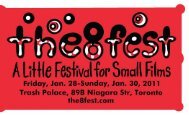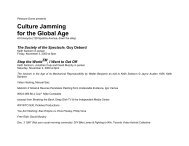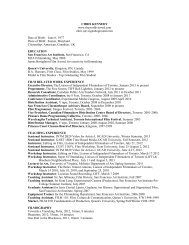Ellie Epp film notes - Chris Kennedy
Ellie Epp film notes - Chris Kennedy
Ellie Epp film notes - Chris Kennedy
You also want an ePaper? Increase the reach of your titles
YUMPU automatically turns print PDFs into web optimized ePapers that Google loves.
<strong>Ellie</strong> <strong>Epp</strong>
<strong>Ellie</strong> <strong>Epp</strong>’s <strong>film</strong>s contain a wonderful economy<br />
of means, but a brilliant energy of ideas. Each<br />
<strong>film</strong> contains only a handful of shots: Trapline, at<br />
the longest, has twelve; current only has two. And the<br />
body of <strong>film</strong> work, with the four only clocking in at<br />
a combined 39 minutes (the length of a perfect LP),<br />
again attests to a concentration of ideas, a honing of<br />
vision that started with her first <strong>film</strong>, back in 1976.<br />
Trapline’s twelve shots were all <strong>film</strong>ed in an<br />
indoor swimming pool in London. Inspired, in part,<br />
by the <strong>film</strong>s she saw at the London Film Congress of<br />
1972, the <strong>film</strong> looks obliquely at some of the concerns<br />
of the structural/material <strong>film</strong>s of that period but<br />
reinvests them with a personal, philosophical vision.<br />
There is a sense of a reduction of elements—the <strong>film</strong><br />
uses water to focus our attention on light—but the<br />
<strong>film</strong> allows for the natural world to enliven these elements<br />
into a rich interplay of ideas.
The setting of an indoor swimming pool<br />
provides a perfect foil for the perceptual interplay<br />
that <strong>Epp</strong> subtly puts in place. The building contains<br />
a natural element and yet protects swimmers from<br />
the elements, allowing them to exercise in all kinds<br />
of inclement weather. But the building itself, as a<br />
container, is not the prime focus. Rather, many of the<br />
shots are aimed down at the water, requesting that<br />
we interpret our surroundings through this elemental<br />
form.<br />
The first three shots reveal a gradual movement<br />
towards a naturalized abstraction, as the elemental<br />
movement of water disrupts the visual forms<br />
of the pool’s architecture. The first shot is a series of<br />
diagonals created by lane markers painted on the<br />
pool’s floor. Over the course of the length of the shot,<br />
the wake of off-screen swimmers send perpendicular<br />
waves that interfere with the linearity of the image.<br />
The second shot treats the reflection of the pool’s<br />
skylight in a similar way, where the sharp lines of the<br />
window frames are seen through the undulation of<br />
trapline<br />
the pool’s surface before three circular ripples, formed<br />
by single drops of water, further counteracting the<br />
composition of the image. The water in the third shot<br />
completely agitates the solid elements in the frames,<br />
as the rigid grid of the brick bottom of the pool undulates<br />
through the perceptual chaos that the surface<br />
wave patterns create.<br />
Four boys swim through the fourth shot,<br />
finally revealing the human element that until this<br />
point has only been understood as an audible presence<br />
on the soundtrack. This shot serves both as a<br />
breather, a moment of recognition and a reminder of
the <strong>film</strong>’s sense of play before we move from liquid to<br />
light.<br />
In the next few shots, light becomes the dominant<br />
element, as the fifth shot catches the reflection<br />
of a large window off the surface of the pool. Vague<br />
human forms walking on the pool deck bend the light<br />
into anthropomorphic forms, but the mixture of light<br />
and water creates a visual interplay that at once hints<br />
at the image (the window frame) and quickly disintegrates.<br />
The next shot finally abstracts to the glance<br />
and dance of light on the surface of the water. At this<br />
moment, <strong>Epp</strong> foregrounds the cinema as a light medium,<br />
reducing the image to the basic element, light<br />
waves caressing the object.<br />
<strong>Epp</strong> directs our attention away from the pool<br />
and at the skylight above it. At first, it seems that the<br />
structure of the space reasserts itself, but over the<br />
course of the shot, the sun, perhaps emerging from<br />
behind a cloud, brightens the image and dissolves the<br />
solidity of the metal frames. With this the <strong>film</strong> both<br />
reasserts the presence of natural cycles against the<br />
rigid structure of a building and rearticulates how<br />
current<br />
even the solid image is made up of particles that can<br />
quickly dematerialize.<br />
With that revelation, it is safe to return to<br />
this solid image, imbued with a new thesis on its<br />
immaterial qualities. The three final shots return<br />
us to physical form and to human presence: changing<br />
rooms, a stairwell and three boys lounging in a<br />
cubbyhole. What has gone before still imprints itself<br />
on these images, both in the sense of their obvious<br />
physical location and in the way the water reflects<br />
in the mirrors of the changing room and splashes
it constantly takes on an active presence. In a lovely,<br />
nondogmatic way, we are introduced again to the<br />
wonders of watching cinema, not just through an<br />
assertion of the beautiful image, but also through an<br />
exploration of the image’s constituent elements.<br />
trapline<br />
against the stairwell. The water is now in a peripheral<br />
space not unlike the way the sounds and impact of<br />
the swimmers articulated the peripheries in the shots<br />
that came before. In the final shot, the soundtrack<br />
completely fades away and the three boys, returned to<br />
physical form, quietly rest in the silence of the formed<br />
image.<br />
Despite its deceptive economy, Trapline<br />
demarcates a series of thoughts on reflection, refraction,<br />
presence and perception. Light either reflects<br />
off surfaces or allows us to look through them, but<br />
--<strong>Chris</strong> <strong>Kennedy</strong>
Filmography<br />
trapline, 16mm, 1976, Canada, 18 min.<br />
current, 16mm, 1986, Canada, 3 min.<br />
<strong>notes</strong> in origin, 16mm, 1987, Canada, 15 min.<br />
bright and dark, 16mm, 1996, Canada/USA, 3 min.<br />
produced on the occasion of Early Monthly Segments<br />
#14: <strong>Ellie</strong> <strong>Epp</strong>, Toronto, April 12, 2010
EMS





